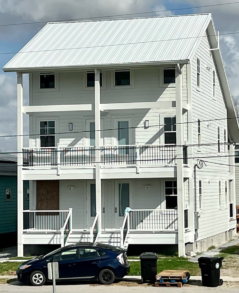
Earlier this month, Canadian Prime Minister Justin Trudeau stood on the factory floor of a leading Calgary volumetric modular builder touting Canada’s intent to invest in manufactured housing as part of a formula for addressing a crisis in housing affordability. The Canadian Prime Minister's approach echoes similar initiatives suggested by Biden’s economic advisors that likely portends more government funding to come across North America.
Government investment may be particularly critical for the sector right now because, lately, private sector investors have proven more reluctant to invest in modular businesses. Still haunted by the ghost of Katerra’s more than $2 billion failed foray into modular construction, many in the industry and in the investment community still look with deep skepticism at the modular sector. Katerra is only one of several high profile failures in modular and offsite construction startups that involved large capital investment, often for expensive, advanced manufacturing plants.
Despite these setbacks, though, the concept of taking a more industrialized, mass production approach to construction is still highly compelling to an industry that faces perpetual labor shortages, dismal demographics, and decades of stagnant and declining productivity. Attempting to solve problems that have plagued the offsite construction sector in the past, an increasing number of industry leaders, investors and technologists are advocating for lighter approaches, incorporating more advanced manufacturing processes in building construction but without the associated investments in additional plants and equipment.
Volumetric Modular vs Conventional Construction
Traditionally, volumetric modular construction refers to building an entire building or an entire room or even an entire bathroom and then shipping it to a jobsite for final assembly. In theory, building a building this way would maximize the opportunity for standardization, automation and the harnessing of the benefits of a controlled environment.
At the other end of the spectrum stands conventional construction where every project is unique and consists of a unique combination of materials provided by a group of suppliers that have been brought together for one time, probably with different subcontractors, different craftspeople, and a fairly low level of tools and mostly rubber-tired, mobile equipment.
In between the two ends of this spectrum, though, there lies a vast ecosystem of modularized, panelized and otherwise easier to assemble, mass produced subassemblies and components. Then there is a third category of solutions. These are the companies that do not own their own manufacturing plants. Instead, they develop digital solutions that help builders standardize purchasing of these easier to assemble components and then combine them “on site” with greater efficiency into more efficient designs.
It is probably less exciting to do a photoshoot in front of a series of z-brick panels or a software screen than inside of a hangar-sized plant, but an increasing number of industry experts believe that the best and most efficient answer for most construction projects may lie in taming the wilderness of all of these “in between solutions” that are made offsite and then assembled onsite.

Shibusa Systems' Kay Reynolds, co-founder and CEO, and Michael Gwynn, chief operating officer, exhibiting at Venture West 2024 Conference.
Shibusa: A Case Study in A Digital Platform Enabling a “Light Manufacturing” Approach to Housing
One such example of a company developing a solution to support builders looking to streamline their process is New Orleans-based Shibusa Systems. Rather than owning a factory that makes buildings or building components, Shibusa favors a process that leaves most assembly of components for the job site and thus avoids the need for the “asset heavy” approach of making housing in an assembly plant. We had the opportunity to meet with Shibusa Co-Founder and CEO Katy Reynolds and Chief Operating Officer Michael Gwynn at the BuiltWorlds Venture West Conference in April.
When we mentioned policy makers' advocacy of manufactured housing, Reynolds bristled. Rather than investing in an expensive manufacturing plant, she argued, it would be better to let the job site remain the assembly plant. In addition, she said, the winning approach would involve developing more standardized designs, more standardized supply chains, and focus on providing builders a “kit of parts” that goes together much more quickly and easily than what they face in a more conventional process.
Beyond not having a plant for modular assembly, Shibusa is not developing its own sites, opting instead to pursue a very lightweight and nimble approach to modular that caters to the existing building industry but also simplifies the skills requirements and lessens the load for craftspeople on the job site.
Canada’s National Catalogue And The Current “All of the Above” Approach to Solving Construction
Shibusa is only one example of many companies operating in the digital modular arena between full scale volumetric modular, offsite component fabrication and more conventional construction. RaaP, a company that sprang in part from an older, asset-heavy modular business, is building a marketplace for modular players in the hotel and multifamily sector, while companies like Msuite help offsite builders streamline their processes.
In the end, it looks like governments have determined that the problem is so vast (US economists estimate a current shortage of as many as 3.8 million housing units) that they will be supporting a full range of possible solutions. So even while the Canadian government and other governments tout volumetric modular construction, they are also pushing the development of a catalogue of standard home designs that would be pre-approved for construction, speeding the construction process and also presumably incentivizing the development of a more standardized supply chain.
It is a move that evokes the Sears Catalogue homes of more than a century ago and a step short of the tech-enabled solutions that offer marketplaces for the standardized process, but it is a nod to the ingredients that may ultimately be more important to the process of industrializing construction: standard designs, standard building codes and an advanced, rationalized supply chain that provides more standardized building subassemblies.

Discussion
Be the first to leave a comment.
You must be a member of the BuiltWorlds community to join the discussion.